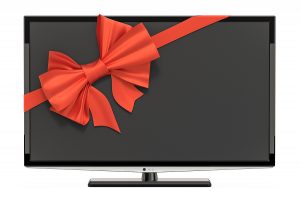It is a new year and manufacturers are introducing new TVs on the market after they sold out of their old ones during after holiday TV sales. And you might think it is a good idea to update your old set and to purchase a Smart TV that comes pre-packed with streaming services and maybe a larger size with that perfect picture that feels like you are in the middle of the action. But before you step into the store you might want to better understand the differences in technology of the TVs on the market.
LCD, LED vs. OLED – What is the Difference
The first decision you need to make is which type of technology you want. The main feature you should be most concerned about is whether you are purchasing a device that has a Liquid Crystal Display (LCD) or Light Emitting Diode (LED and OLED) display.
The basic technology for both is about the same. They have two layers of polarized glass through which the liquid crystals both block and pass light. LCDs use fluorescent lights while LEDs use light emitting diodes. The fluorescent lights in an LCD device are always behind the screen. On an LED device, the light emitting diodes can be placed either behind the screen or around its edges. The difference in lights and in lighting placement has generally meant that LEDs can be thinner than LCDs, although this is starting to change. It has also meant that LEDs run with greater energy efficiency and can provide a clearer, better picture than the general LCDs.
LCDs have a wide viewing angle without light degradation or color. With LED screens, the best viewing angle is dead center, and the picture quality diminishes in both color and contrast the further you move to either side. While the severity differs between models, it’s always noticeable.
In contrast, OLED screens can be viewed with no luminance degradation at drastic viewing angles — up to 84 degrees. This compared to LED TVs, which have been tested to allow for a max viewing angle of 54 degrees at best.
However, LED and OLED devices emit very strong blue light waves which for those who are susceptible to getting migraine headaches are like sunlight to Dracula. This is because these devices do not provide a constant source of light, they are actually flickering. This flickering triggers migraines and is well known for causing eye strain and headaches. This combination make blue light dangerous for migraine sufferers. Learn more about how blue light affects your vision. If you experience these conditions it is better that you purchase a TV with LCD technology which will be better for you.
If you still insist on purchasing and using an LED or OLED device there are ways to reduce the blue light emitted from the screen. Apple devices have an option called Nightshift that can be found in the Display and Brightness area under Settings. This option allows the user to either automatically or manually reduce the amount of blue light emitted by the device. For those on other devices there is software called F.lux that can be downloaded for free which will do the exact same function. For LED and OLED televisions you can go into Settings and reduce the amount of blue hue or color strength. Each TV has different ways to do this, but they all work.
So where does NuShield come into the picture?
What you will notice about all these different televisions is that they have a very shiny display surface. In dark areas this is not a problem, but once there is a light source hitting the surface of the display you will see more glare and reflection than the image on the screen. And if you plan to put the TV out on the back porch or in a three-season room the reflections from your surroundings are multiplied.
The NuShield Triple A screen protector film was created to eliminate all reflections and make screen visibility possible from all angles. The Triple A film offers anti-glare, anti-fingerprint and anti-microbial protection. The film is soft and easily applicable, even on televisions and big as 80-inch diagonal. The tacky surface sticks to the screen but can be lifted and reinstalled if necessary. And if you have to remove the film from the surface even after several years, you’ll find that the display surface still looks as great as before the film was applied.
The Triple A film is available for over 1,000 different televisions and over 15,000 other devices. NuShield is constantly adding new sizes as they come on the market or you can provide screen measurements and NuShield will create a new film size to fit your screen without additional cost to you. Look for your device here, but if it is not listed you can contact us and we will work with you to create a size that fits your device.

